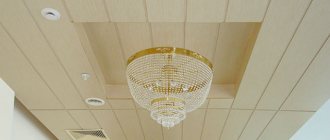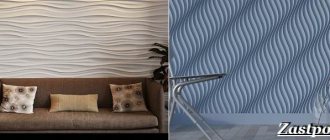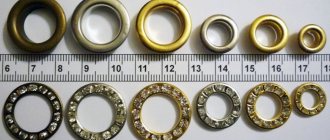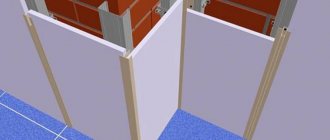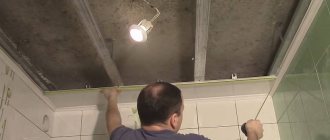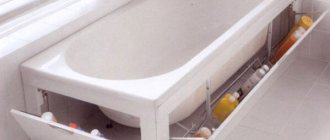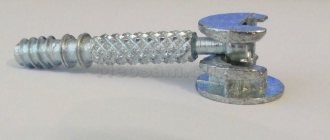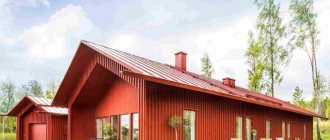What is it and what does it consist of?
MDF is a medium density fibreboard. The two most common forms of material are panels and sheets. Quality and service life do not depend on the shape.
It is made from small sawdust, just like chipboard. But in the case of MDF, smaller sawdust is used, which allows you to create a more dense and reliable structure. Correct slabs are smooth, even and uniform, so they are easy to work with - veneering, processing and milling.
The holes are made without problems, and without crumbs and shavings. You can even apply a complex pattern. In its behavior, MDF is similar to wood, but has a more affordable price.
The material is not afraid of water and can withstand up to 80% humidity, so it is often used in the kitchen or even in the bathroom. Note that real wood can only withstand 60% humidity.
Although MDF can be called a very durable material, it is also flexible. It produces round objects without any problems. The photo shows the panel in section:
Installation and use of MDF panels
MDF panels and lining are often used for cladding walls and ceilings, but you need to choose the right installation method. The most universal solution is a wooden or metal sheathing, which will also hide all defects in the foundation and communications. This option is suitable for walls made of any material - just choose the right fasteners.
Tongue-and-groove panels and panels with a flat end can be laid exactly end-to-end. If you want to cover the entire wall with slabs, this is the option for you. But more often MDF is combined with other finishing materials, and the ends are covered with decorative thresholds and baseboards.
MDF panels with high-quality coating do not require difficult maintenance, do not fade or deform. Remove any dirt with a regular damp cloth without chemicals. The main thing is not to use abrasive materials, not to abuse the amount of water and not to use too aggressive household chemicals.
What does this abbreviation mean?
It is simply impossible to decipher the abbreviation in Russian, since the name was simply taken and copied from English - MDF, or Medium Density Fiberboard, which translates as medium density fiber board. If desired, you can add a small clarification: wood fiber.
There is no fundamental difference in which decoding to use - it’s a matter of habit. But since the very appearance of MDF took place in 1966 in the USA, therefore the English name is preferred. This building material reached Russia only 31 years later, namely in 1997.
At the moment, the People's Republic of China is considered the leader in MDF production.
What is MDF
MDF is a board that contains fine wood . The thickness of the product varies in the range of 2-60 mm. The name was preceded by the appearance of the abbreviation in English MDF .
A special feature is durability and ductility . You can make holes to assemble the structure using a router or screwdrivers . The sheets quickly bend without breaking , which allows you to come up with various configurations and give the furniture a unique appearance.
In practice, you can find types that have already been sanded , coated with a special PVC film , using a glossy or matte surface.
Before applying natural veneer, the client must distinguish this material from solid wood. Can be used in rooms with humidity levels up to 70%.
Production technology
Modern production makes it possible to create an almost identical copy of the natural structure of wood. The finely dispersed fraction of wood has its own operating characteristics, due to which it has many advantages. But let's start with the stages of MDF production :
- Preparation . The logs are cleared of bark, crushed into chips and sorted, clearing them of debris and dirt. Heat by steam.
- Formation of fibers. The resulting chips are crushed as much as possible in a special machine - a refiner. This is necessary to release the natural resin from MDF - lingin, which will later act as glue.
- Formation of the slab. The prepared mass is sent to the machine, where it is laid in the form of a sheet using rollers. This is where pre-compression occurs.
- Pressing. At this stage, the chips finally take on their future shape. After pressing, the material must cool for half an hour. The unsanded sheet is then processed until smooth.
Advantages of modern material
Wood-based panels retain the full range of advantages of natural wood. In the production of wood-based panels, natural wood is used with the addition of special components. This allows you to achieve high performance indicators that can solve many technological problems.
Thanks to the advent of MDF, those advantages of natural wood that are advantages have been preserved. However, unlike wood, which can dry out or swell, MDF is moisture resistant and does not change its size under the influence of external factors.
Wood is more susceptible to burning than synthetic materials. In addition, wood can also be of different quality depending on the type of wood, the area where it grows, and the location of the fibers. Can change its mechanical characteristics.
To produce MDF, the log is stripped of its bark and ground into powder. Next, the composition is processed, steamed, and a complex of binding substances – paraffin and lignin – is added.
The composition of the mixture is leveled, pressed and cooled.
MDF has a number of undoubted advantages:
- ease of installation work;
- good thermal insulation quality indicators;
- environmentally friendly, without the release of harmful substances in the form of formaldehyde, which is inherent in chipboard;
- availability upon purchase.
The furniture industry uses MDF to create framed facades and cabinets. Here about kitchen film facades.
Facades
Separately, the material is used for covering floors, walls and doors .
Acoustic systems also need MDF due to its ability to perfectly absorb sounds. Some types of MDF are used for the manufacture of packaging materials.
Acustic systems
If you decide to use MDF for finishing work, the dimensions of the sheet and the price depending on the thickness are indicated in the photo. For finishing you will need to do their edging. For this purpose, take a set of decorative strips .
Decorative strips
In order to secure them, a special sealant or liquid nails are used.
Sealant
To paint MDF, if you decide to do it yourself, there are several requirements. It is necessary to first clean and rub the surfaces, then wipe them using a solvent. After this we prime by applying two layers of primer.
To apply paint, it is better to use a spray can, a brush and a spray gun. When the surface has dried, it can be varnished. For an already painted facade, you will need a primer that is water-based. It will hide the texture features.
When choosing paint, give preference to polyurethane enamel, which is characterized by wear resistance, as well as acrylic paint.
Polyurethane enamel
When choosing a paint color, make sure it matches the interior tones. Painted MDF panels require care when caring.
What are the benefits of MDF furniture?
The material is very popular for making furniture, as it has the following parameters:
- resistance to temperature and moisture;
- ease;
- ease of installation;
- prevalence;
- strength, resistance to wear and mechanical stress;
- good level of sound insulation;
- resistance to microorganisms;
- ease of care;
- durability;
- reduced flammability;
- low cost.
In addition, MDF panels also look beautiful, so they are often used for design solutions. But there are also negative sides. These include:
- low strength of thin sheets;
- limited choice of textures and colors;
- possible reduction in space due to the installation of a frame under the panels (when covering walls).
Using MDF
The main consumer of slabs is the furniture industry; they are often used for finishing interior spaces for various purposes.
Decorative wall panels
Laminate is made on the basis of MDF, furniture facades are finished with decorative threaded elements.
Furniture facades made of MDF
Another feature of the slabs is that during milling they emit dust, which makes them an excellent material for milling shapes of complex geometry.
3D CNC milling of MDF
Artistic milling of MDF
Specifications
Due to some of its characteristics, MDF sometimes stands even higher than wood. One of these features is that the slab can be bent at any angle, giving the furniture an unusual shape. A medium-hard board can withstand pressure up to 15 MPa. In addition, fungus and other pests simply will not settle in such material.
There are certain standards that companies must adhere to when making the material. For example, the density level - it should be from 720 to 980 kg/m3. Hence MDF boards are divided into two types :
- LDF - low density board (up to 600 kg/m3);
- HDF - high density board (from 800 kg/m3).
Of course, HDF boards are of higher quality, but they will also cost more.
There are also several types of slabs based on quality.
| Variety | Description |
| I | An excellent choice - homogeneous, smooth products, no chips, scratches, roughness or other defects |
| II | Minor defects are allowed - gouges and scratches up to 2 cm long and up to 0.03 mm deep, small chips on the edges, slight roughness |
| III | Instances with pronounced defects - scratches, damage, chips, roughness. This option is suitable for construction purposes. |
Some designers recommend specifying the emission class. This characteristic is responsible for whether the material will release formaldehyde, and in what quantity. According to GOST there are only two emission classes :
- E1;
- E2.
The first class is allowed even for use in children's premises, since such a panel cannot cause any harm. It is these types of specimens that are most often found in construction stores.
Advantages of MDF
Finely dispersed raw materials for the manufacture of MDF boards ensure high density and homogeneity of the structure, and hence the strength of the material. The slabs hold well even when loaded with mechanical fasteners, so you can hang shelves and cabinets on them.
The same finely dispersed structure guarantees a perfectly smooth surface without splinters and roughness. Therefore, MDF panels can not only be laminated, but also decorative enamels, PVC film, and plastic can be applied.
In damp rooms, MDF is not afraid of fungus and mold, but be sure to take care of treating all ends. From the outside, the slab is completely impenetrable; the main thing is to prevent moisture from getting inside through the raw edges.
MDF boards are easy to cut, sand and bend, making them suitable for fine and fine workmanship. These can be figured elements, carvings, decorative facades and even radius furniture with concave outlines.
MDF is not the cheapest alternative to wood, but slabs are still much cheaper than solid wood. In the furniture industry, cabinets are often made from cheap chipboard, and facades are made from decorative MDF.
Types of panels
Another important nuance for choosing an MDF panel is its release form . They are distinguished:
- Rack type. It is a very elongated rectangle 2–3 meters high and only 15–25 centimeters wide. Such panels are used for ceilings or walls, so they have a lock. When choosing, you should pay attention to it: the lock must be no shorter than 5 mm - otherwise it can simply break off.
- Tile type. The maximum size of such a panel for a wall is one meter per meter. They can be either square or rectangular. They are most often mounted on a frame or on a hidden fastening system (if available).
- Sheet material . Rarely used in decoration, but useful in making furniture. Although the scope for imagination is not limited.
Disadvantages of MDF panels
The main weakness of the plates is their sensitivity to high temperatures. With constant overheating, the decorative coating cracks or peels off, and the surface becomes deformed. Be sure to take this into account if you use MDF when decorating your kitchen.
The pressed material does not withstand shock loads well, because falling heavy objects or strong impacts can leave dents on the base. Therefore, MDF boards are not suitable for finishing floors and require additional protection when making kitchen countertops.
Classification by finish
After manufacturing, the material has a gray-brown color, so it is problematic to fit it into the interior. The surface can also be refined. We will now look at several ways to do this.
Veneering
The slab is covered with veneer, that is, a thin cut of natural wood. Of course, after this the surface cannot be distinguished from an array, but in addition to this, the quality also increases. The veneer is attached with glue, and experts call this the beautiful word “veneering”.
This method of decoration gives the facades a very realistic look. This is not a cheap pleasure, but the following advantages appear:
- moisture resistance;
- resistance to warping;
- do not dry out.
Fine-line
This finish can be called a subtype of the original veneer. Fine-line is also called eco-veneer, since sections of inexpensive and soft wood, such as poplar, are used.
Thanks to this feature, such a material is much cheaper than “real” veneer, but still perfectly conveys the grain of the wood.
Stone veneer
Another type of veneering. In this case, the thinnest possible cut of natural stone is used - about 1-3 mm. Sometimes polyester resins are used, but they look like natural stone.
This surface is resistant to any conditions, even mechanical tests. The only drawback is the small selection of colors.
Plastic
This type of finishing is most often used in furniture production. The idea is simple: a very thin layer of plastic or acrylic is glued onto an MDF panel. In this case, it is necessary to monitor the quality of edge protection - it can be either plastic or aluminum. Without them, the façade will not last long, since the panels will begin to come off and dirt will accumulate underneath them.
Since plastic is used only as a top layer, the question of which is better—a kitchen made of MDF or plastic—is not even worth asking. They go inseparably. We should only talk about comparing finishing materials for MDF, for example, enamel or plastic, acrylic or veneer.
PVC film
If the chosen surface is not a flat one, but one with a pattern, then the slab is first milled and then covered with a film under pressure so that the latter fits into all the recesses of the pattern. This type of panel is also called laminated.
The film can imitate a wood structure, repels dust and increases the panel's resistance to mechanical stress. The surface can be either matte or glossy of any shade.
The main advantages of film MDF include:
- strength;
- resistance to moisture and ultraviolet radiation;
- hygiene;
- Possibility of chemical care;
- Dirt resistance.
High gloss film
The essence of high-gloss film is that it is applied seamlessly - simultaneously to the front facade and side edges. Due to this application, the furniture turns out to be very beautiful, smooth, even and shiny. This service is not yet so popular, so the choice of colors for furniture is limited.
Coloring
After painting, the slab becomes more protected and acquires a pleasant shine. Painting can be either automatic or manual. Enamel, UV varnish or other flexible paint options are suitable. This coating is not as stable as previous analogues, but still protects against previous factors.
The same cannot be said about special enamel paint. It is applied in several thin layers and even protects from mechanical stress. It is also not afraid of moisture and pollution.
But there is one peculiarity - such a coating should never be rubbed with hard sponges: noticeable scratches will remain. Such kitchens most often have a strong gloss. Matte options are more expensive as they require additional processing. But it is easier to care for such a coating.
We recommend reading: Which kitchen is better to choose, glossy or matte?
Soft Touch
One of the varieties of matte finish is Soft Touch. This is a special paint based on rubber varnish. There are no fingerprints or scratches on it, and it does not glare in the sun, creating the impression of a velvet surface. It is very practical to clean, since drops of fat and other dirt are simply not visible.
How to attach MDF panels to the wall and ceiling with your own hands
Even if you have not worked with such material before, it is quite possible to figure out on your own how to attach MDF panels to a wall or ceiling. And first of all, you need to prepare tools and materials. This list includes a simple pencil, a corner for marking right angles, a construction level, a hacksaw, a hammer drill, a screwdriver or hammer, dowels and screws.
The work begins with cleaning the surface on which the fastening will be made. It must be thoroughly cleaned of dust and dirt. In addition, it is necessary to conduct a thorough inspection for the presence of fungi and mold.
If you need to make a ceiling from MDF panels with your own hands, then you will need both guide profiles and hangers, plus wooden blocks that will act as transverse parts of the frame. If we are talking about attaching MDF panels to the wall, then simple wooden blocks or a special plastic sheathing will be enough.
Helpful advice! To make the fastening process easier, it is recommended to use clamps. This will allow you to fix parts of the covering on the sheathing and, in general, will make the task much easier.
Do-it-yourself installation of MDF wall panels on lathing
The most important thing is to make the correct markings for the sheathing, which in the future will allow you to accurately secure all the elements. How to do this correctly can be seen in the photo of ceilings made of MDF panels. At this stage, it is important to take into account that the distance between the fixed panels and the real ceiling should be sufficient to accommodate lamps, as well as other communications.
Installation of MDF wall panels also begins with marking the place where the first lathing strip will be attached (vertical or horizontal does not matter). Maintaining the required distance, all sheathing elements are attached, and after that the installation of MDF wall panels begins. They are fixed quite simply using clamps or self-tapping screws.
Helpful advice! High-quality and certified products can be found on the official Soyuz website. MDF wall panels made from them are highly valued due to their compliance with all requirements and standards.
This is not to say that installing MDF panels on a wall with your own hands is a difficult process. Rather, it is monotonous and requires high accuracy of calculations and constant attention.
Related article:
Thickness and dimensions of plywood sheets: prices, varieties and applications
Plywood: production features, main types of this material, advantages and disadvantages. Review of the building materials market.
Comparison with chipboard/chipboard
Chipboard is also made from wood chips. To glue it and give it the desired shape, resins are used, which do not always meet environmental requirements, so such furniture is undesirable for use in the kitchen, although it is very popular.
Due to such differences in the production process, chipboards are not as dense: a maximum of 650 kg/m3, which means they are more susceptible to the effects of water and steam, and are not so durable in general.
For example, when wet, a chipboard board actively absorbs moisture and can increase in volume by about 30%. In this case, we can distinguish laminated chipboard - that is, ordinary chipboard, which is covered with a film on top, or laminated. This material is not afraid of moisture due to the protective top layer, so it is often used to create budget countertops.
But you should understand that if the top layer deteriorates or is damaged, the chipboard will immediately reveal all its shortcomings.
We wrote about what is better for the kitchen - MDF or chipboard >>>
MDF has the following advantages over chipboard:
- with equal thickness, MDF will be twice as strong;
- the ability to form reliefs of any complexity;
- easier to process;
- smoother surface;
- more environmentally friendly;
- not demanding on operating temperature.
But most kitchen furniture, including facades and countertops, are now made of chipboard. Such a set will not last long - about 10-15 years. But thanks to the low cost, this can be even more profitable than one set from an array for 40 years. If environmental friendliness is important, then it is better to choose MDF panels.
MDF or chipboard, which is better? Advantages and disadvantages…
Chipboard or MDF?
The difference between chipboard and MDF is in the manufacturing technology, because chipboard is a chipboard with formaldehyde resins as a binder. The composition contains more chemical components, the fraction of raw materials is larger, and the density of the boards is lower.
Chipboard is also considered a safe material, but still loses to MDF boards in this regard. It also loses in terms of resistance to moisture, because particle board swells over time. But chipboard has higher resistance to temperatures above 70 degrees.
Comparison with natural wood
Even over natural wood, MDF has advantages:
- equal density over the entire surface of the slab;
- absence of natural defects - for example, knots, voids, etc.;
- possibility of embossing and other special processing;
- resistance to microorganisms and fungi;
- the cost is 60–70% lower.
Solid wood furniture belongs to the expensive and elite category. Russian oak is valued more than others - it is also used for veneer.
The most budget option is birch or pine. Such a set will last 40 years or even more - the main thing is that you don’t get tired of it. But no matter how beautiful and prestigious such furniture may look, it is very sensitive to temperature changes and is also difficult to maintain. For these reasons, the array is now being replaced with veneered MDF.
Step-by-step instructions for installing an MDF apron
As an example, let's look at the instructions for installing an MDF apron with decorative photo printing. The installation is done in an existing kitchen; there is no need to do any special preparatory work.
Step 1. Bring the stove into the room and remove the packaging materials.
Removing packaging
Removing the packaging film
If the apron was stored in an unheated room in winter, then you need to give it at least a day to acclimatize. During this time, the temperature in the room and on the front side will equalize, and the condensation will evaporate. Do not rush to get to work right away; check the moisture content of the ends of the slab by touch.
Step 2. Place the stove on a flat surface; the dimensions of the table should be approximately equal to its linear parameters. Always remember that manufacturers advertise only the positive aspects of their products. If they claim that MDF is easy to cut, and this is true, then at the same time this means that it has low mechanical strength. If a large area hangs down, it may crack under its own weight. Take the dimensions of the apron and transfer them to the back side of the slab.
Marking along a ruler
Step 3. Using an electric jigsaw or other tool, carefully cut off the excess. You should work very carefully, as a small piece of MDF may break off and the edge will become uneven. Use one hand to support the material at all times. If it’s hard, stop longitudinal cutting, make a transverse cut and break off part of the slab.
Cutting the apron
Step 4. Transfer the locations of the sockets in the kitchen area to the apron. This is done in several stages.
- Remove the protective decorative covers from the sockets. Pay attention to the margin with which they overlap electrical boxes; this data will help you navigate with maximum tolerances.
Measurements of socket boxes - Make marks on the surface of the sheet. If you are working on the front side, then you should use only children's markers. They are made with water and are easily washed off; if you work on the reverse, then the locations of the sockets should be marked in mirror images.
Transferring markings to the apron
Step 5: Cut holes. First you should drill, the diameter of the drill should allow the jigsaw to enter them.
Drilling holes
When working, it is advisable to place paper or cardboard under the jigsaw table, this will prevent damage to the front side of the apron.
Sawing with a jigsaw
Holes for sockets and switch
Step 6. Apply liquid nails to the wall, do not skimp on material. It is necessary to ensure strong adhesion.
Application of adhesive composition
Spot application
Step 7: Lean the slab down and press it firmly with your hands.
The plate is pressed tightly against the wall
Do not leave gaps; the material must adhere to the entire surface. If the wall is uneven, then you should increase the amount of glue; do not be afraid that there will be too much of it and it will remain liquid. The composition hardens not when moisture evaporates, but due to chemical reactions. The catalyst is moisture in the air. This means that, despite the thickness, the glue will harden and will firmly hold the apron.
Step 8. Insert all the elements of the sockets into place; they will additionally secure the apron.
Installation of sockets
Attaching decorative trims
Completion of installation of switches and sockets
The rod is fixed
MDF apron
The technology for installing these kitchen design elements is so simple that almost all beginners can do it.
Comparison with plywood
MDF also has advantages over plywood:
- absence of external and internal defects such as knots and holes from them, veneer overlaps, cracks, and so on;
- perfectly flat and smooth surface;
- no deviations in the width or length of the sheet;
- not afraid of exposure to steam;
- more favorable price.
But at the same time, plywood is more durable. This is due to the manufacturing process: solid wood is used for plywood, and only its fibers are used for MDF. It is not customary to use plywood for kitchen furniture or even backsplashes.
Types and parameters
The main characteristics are:
- leaf density and weight;
- flammability;
- formaldehyde emission, that is, is it harmful to use the material and to what extent;
- water resistance,
completely correspond to the original chipboard material, which we talked about in this article.
Therefore, the laminated material
differs only in parameters related to appearance , that is:
- type of edges;
- type of front surface;
- color or pattern of laminated surfaces;
- shape and size;
- appointment.
Most types of laminated chipboard are intended for use in dry rooms , but sometimes moisture-resistant and even weather-resistant samples are found. Therefore, it is necessary to carefully look at the information specified in the accompanying documents and stamped on the back of each part.
Edge type
There are 4 types of edges on laminated chipboard sheets :
- smooth without finishing;
- tongue and groove;
- flat with a groove for installing a plastic edging;
- with the same color/texture as the front side, covered with laminating film.
The first type of edges is found in sheets of large size and for any purpose. Plates intended for cladding walls or covering floors and ceilings do not need edge finishing , because they are joined end-to-end, and the temperature gap is filled with a sealant of a matching color.
Tongue-and-groove chipboards are designed for a variety of coatings and sheathing without the use of sealant, so the tongue tongue is covered with the same finish as the face. Find more information about this type of edge here.
Grooved edges are made from slabs intended for furniture assembly and cut to size in the factory, so they are not common. After all, in any furniture workshop there is a hand cutter or a special machine with which you can cut such an edge yourself.
Material intended for making furniture is often laminated on all sides, including edges . This has almost no effect on its cost, but it greatly facilitates the work of those who will make tables, cabinets or other furniture from it.
What is the front surface?
Usually, for the manufacture of laminated chipboards, chipboards of the corresponding water resistance classes are taken, so their surface is even and smooth .
There is also a material with a figured front surface , which can be covered with “orange peel” or equipped with a chamfer along the edges.
They also produce laminated chipboards with imitation wood pores and other types of irregularities. All types of irregularities are formed using a special coating, which is glued to the chipboard in front of colored paper or decorative film.
Therefore, the uneven front surface does not have high strength, and it is installed only on slabs for furniture, as well as cladding of ceilings and walls.
Shape and dimensions of sheets
There is no document that strictly regulates the dimensions of laminated chipboard, so each manufacturer adheres to its own dimensions, which is why there are often cases when slabs from different manufacturers cannot be laid without trimming. Also, accordingly, how much a particular sheet of material weighs depends on the size and density.
Typically, the length of large sheets is 2.5–5 m and the width is 1–2 m. The length of medium-sized sheets is 1.5–3 m and the width is 0.5–1 m. There are also small slabs whose length is 1– 2 m, and width 10–50 cm.
Regardless of the size, the shape of the sheets is always rectangular , because Russian and foreign standards allow a deviation in the diagonal length of no more than 0.2% of the length of the slab.
That is, with a length of 3 m, the maximum diagonal deviation cannot exceed 6 mm. The adjacent sides of laminated particleboard, which are produced by well-known manufacturers, are always located at an angle of 90 degrees , however, deviations in length and width (±5 mm) are possible when comparing boards from different batches.
Color and surface pattern
Before lamination, all laminated chipboards are pasted over with paper on which a pattern or a single-color color scheme is applied, so theoretically it is possible to give this material any color or apply any pattern to it. Manufacturers compile catalogs of categories, colors and patterns, the most popular of which is imitation wood texture .
Often they use imitation parquet or mosaic masonry. Sometimes in stores you can find laminated chipboard with a brickwork pattern or an imitation of the polished surface of granite, marble or other natural stone.
To give the surface of the slab irregularities corresponding to the pattern, embossing is used .
To do this, a lining is placed between decorative paper or film, on which the required pattern is formed using stamping and heating , after which the decorative layer is glued.
This processing method allows you to create surfaces that are visually and tactilely almost indistinguishable from the materials they imitate. Detailed information about the production of such slabs can be found here.
Purpose
Manufacturers often indicate the purpose of the finished product :
- furniture manufacturing;
- floor finishing;
- finishing wall cladding;
- finishing of partitions;
- finishing of ceilings.
Theoretically, laminated chipboard intended for wall cladding can be used for floors or ceilings, but in practice this will only lead to an increase in the cost of work and a decrease in the quality of the coating.
After all, slabs intended for flooring have higher compressive strength, and their coating is less susceptible to abrasion.
Sheets intended for finishing ceiling cladding differ among those that are commercially available in their minimum density and thickness, and for wall cladding, slabs with minimal strength are used. All this affects the cost and performance properties of laminated chipboard.
Sheets intended for making furniture have higher strength, and their coating is not designed for high loads. At the same time, the thickness of the furniture material is usually higher than that recommended for finishing ceilings or floors, and is comparable in size to sheets intended for cladding walls and partitions.
In addition, double-sided lamination is used only for laminated chipboard intended for cladding partitions and making furniture. For more information about where and how laminated chipboard is used, read this article (Application of laminated chipboard).
Comparison with fiberboard
Fiberboard is a material also made from wood chips. The difference from MDF is the use of synthetic resins to strengthen the wood board.
The plate is made by wet pressing, so its back is not smooth, but resembles a mesh from a brand on cottage cheese. This is not the best option for the kitchen, as dust may accumulate.
To better imagine this material, you need to remember the back wall of some cabinet - that rough material is fiberboard, or, as it is sometimes called, hardboard.
Fiberboard is not afraid of moisture and temperature changes, but at the same time it is also low in cost. But the manufacturing process itself does not allow making hardboard thick, so it cannot be used as a facade or countertop in the kitchen. The maximum is the back wall of the kitchen unit.
MDF and laminated chipboard: what is the difference
The production of laminated chipboard is carried out on the basis of chipboard, which consists of compressed shavings and sawdust , and for strength, the structure is impregnated with formaldehyde resins . The top is covered using melamine film . With its help, resins can be retained inside the material until mechanical damage occurs. The market offers options with different densities in the range of 300-600 kg/m³ .
Innovative are used in the production of fine-grained slabs . Initially, the fiber is dried, and then a hot press is used. The composition uses only fine sawdust .
Through the press, the structure acquires a homogeneous composition. The surface is smooth, so, unlike the first option, no additional grinding is required.
How to choose and buy panels?
The choice of MDF panel should be based on where it will be used - hence the focus on different characteristics. For example, painted panels are quite suitable for the kitchen, since they have increased resistance to moisture and steam. But this will still not be enough for the bathroom - only laminated materials (LMDF) are suitable here.
If any additional finishing work is planned on the furniture facade, then it is best to select veneered MDF. If it is necessary to decorate large spaces, ordinary tiled MDF will do.
It is important to pay attention to the manufacturer. Of course, as you can see above, the choice of domestic brands is wide, but foreign materials, for example, from Poland, Sweden and Germany, have the best reputation. But copies from China cannot boast of quality - they charge a price.
In any case, before purchasing, it is necessary to conduct a thorough inspection of the selected material for the kitchen:
- check the surface for smoothness and absence of chips;
- there should be no smell;
- the color should be uniform.
Such a thorough check is due to the fact that some unscrupulous manufacturers, under the guise of MDF, sell laminated chipboard panels, which are inferior in quality and strength.
Caring for kitchen units
To preserve the appearance of the product and extend its service life, you must follow the rules for cleaning and care. They will differ in the type of finishing work performed.
Quite often, MDF coating is used with veneer, which is made from valuable wood species. However, the use of this coating carries a number of restrictions for the operation of furniture.
The location of such products near heating appliances is excluded.
To remove dirt from the surface, use a slightly diluted soap solution. Cleaning of MDF products is carried out using window surface cleaners based on ethanol, which is also perfect for this purpose. After applying the alcohol composition, you must immediately wipe the surface.
What can you make with your own hands from MDF?
At home, you can make almost any furniture and decoration from this material (set, table, chairs, apron, ceiling, etc.). The main thing is to have two things:
- good tool;
- skillful hands.
If these two components are found, then it’s just a matter of fantasy and imagination. Some craftsmen make their own kitchen sets from MDF - this results in excellent savings. An example of such amateur activities that can be done is in the photo.
Would you like to repeat something similar? For cutting MDF panels at home, a jigsaw with a suitable blade is best - this work is the easiest and fastest. If you don’t have a jigsaw, you can get by with a saw or even a grinder.
Interesting read: Painting and patination of MDF kitchen facades in 7 steps
Wall panels
The ease of installation of MDF allows you to mount it yourself. To do this, you can use several options.
If you decide to install the panel with glue, you should definitely take into account that the surface for joining should be as flat as possible.
It is also necessary to use special brands of glue and adhesive solution.
Wall panels
Where the panel adjoins the sheathing, it is necessary to carefully apply glue. You can fasten MDF with nails, screws and staples. They are used where a constant level of humidity is ensured. The type of mechanical fastening with clamps involves fastening to the sheathing using staples, nails or self-tapping screws.
Fastening with a clamp
Care
The performance qualities of MDF are quite high, so furniture or decoration does not require special or complex care. However, to extend service life and maintain a presentable appearance, the following rules should be followed:
- wipe with a clean and damp cloth;
- maintain the temperature at a level of 10 to 40 degrees;
- do not use solutions containing chlorine or acids;
- use soap solution;
- do not scratch, trying to tear something off, for example, with scissors or a knife;
- polish using special wax or silicone based products.
All these rules apply rather to kitchen facades. Caring for other MDF furniture most often comes down to wiping with a dry cloth.
Properties and composition
The main advantages of the material include:
- Decorativeness . You can take several types of MDF for finishing and they will complement each other perfectly. Their external surfaces provide the opportunity to create various patterns and imitate the structures of natural materials.
- Durability . They can be securely fastened; the hardness of the slabs is similar to natural wood;
- Durability . MDF sheets are resistant to temperature changes. They do not warp or crack during service. Thanks to a special production technology, fungus does not appear on them. Such panels are resistant to moisture, ultraviolet radiation and insects. At the same time, the material does not require special care or additional protection.
- Moisture resistance . The material is known for its low hygroscopicity and therefore does not corrode. Its dense, homogeneous composition allows the use of MDF for kitchen furniture.
- Environmental friendliness . The production of boards is such that the base material and its binder are natural. During operation, it does not emit hazardous fumes and is non-toxic.
- Versatility . Due to its high manufacturability, it can be used in various rooms. It can complement any decor.
- Ease of installation . Its installation does not require professional skills or special tools.
- Hygiene . The surface of the material is easy to care for; it has a dirt-proof function, so frequent wiping is unnecessary.
- Soundproofing . When decorating walls with such panels, an air gap remains, which inhibits the passage of noise from the outside and prevents heat from leaving the room.
- Price . Compared to natural wood, the price of the material is affordable.
You can find out more about MDF kitchen aprons here by reading the article.
The video describes the composition of MDF panels:
